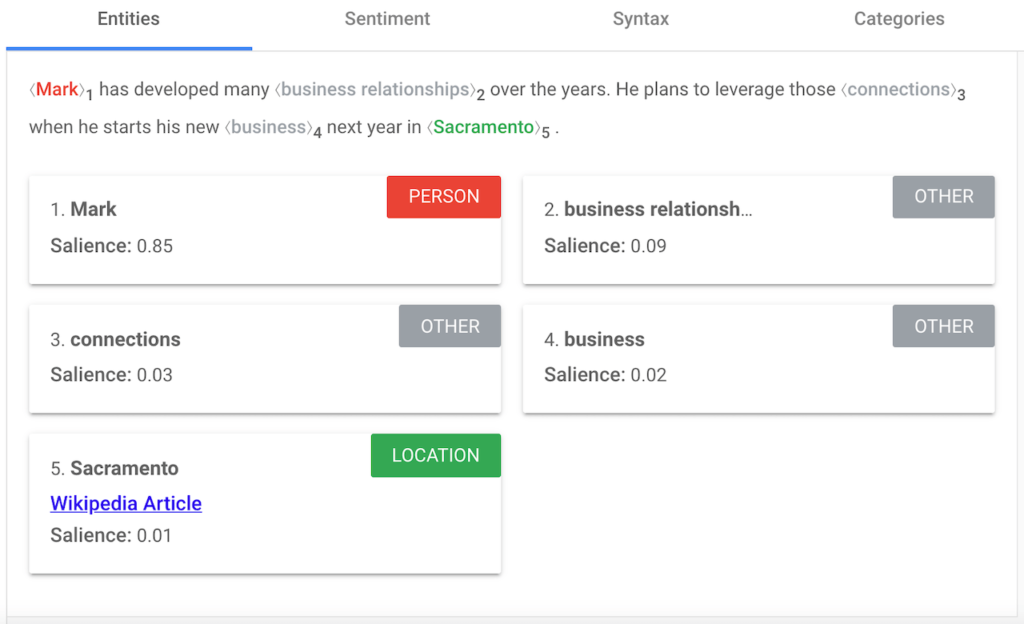Author’s Note: This post was published before ChatGPT appeared on the scene and radically changed the AI landscape. We will periodically update this post with the AI applications for marketing.
In 2011, Marc Andreessen famously wrote a post entitled, Why Software Is Eating the World.
Now, artificial intelligence is eating the world.
A part of the world that AI is taking a bite out of is digital marketing.
If you are a human marketer, don’t worry — yet. People are still core to marketing.
As Janelle Shane points out in her whimsical & informative book about AI, You Look Like a Thing and I Love You, AIs still have the approximate brainpower of a worm.
Despite a low level of intelligence compared to humans, AIs have already made marketers at companies of all sizes better at their jobs.
AIs simplify the evaluation and purchasing experience for consumers and B2B buyers. Buyers can make more informed decisions.
As with other business software, capabilities that were once only available to enterprises are now available to SMBs. Notably, both Amazon and Google developed AI-powered marketing applications for internal use that they have turned around and are now selling to businesses of all sizes and across industries.
What are some of the ways that AI is eating the digital marketing world?
Below is a categorized listing, some with examples of tools from AI vendors. A number of these are tried and true. A few are more conceptual.
Note: We’ll use AI as an umbrella term to cover several of its methodologies — machine learning, deep learning, computer vision, and natural language processing.
User Experience
Product & Content Recommendations
Anyone who shops online has experienced an AI making suggestions for future retail purchases. You may not remember when product recommendations were a staple of an online retailer’s marketing efforts.
Spotify and YouTube both have recommendation engines that are known to many. Google markets its Recommendations AI solution to online retailers.
Content marketers can use the same approach to recommend downloadable assets like checklists and white papers to business users.
AI enables a company to personalize a prospect or a customer’s experience. It helps website users discover products, services, and content that match their tastes and preferences.
Retargeting
Targeted ads are better for consumers and marketers alike. A machine can determine which ads a customer will most likely click.
Over the last few years, I have heard many people lament that they often get retargeted with an ad for a product they just purchased. But this is more of a data problem than an AI problem.
Chatbots
Marketers have widely adopted AI Chatbots.
A digital marketer sets up a chatbot to answer a website’s visitors’ questions conversationally.
A chatbot’s underlying AI can pass along any questions to a human who has not gathered enough data to provide a meaningful answer.
Content Creation & Editing
Short form copywriting
GPT-3 connected AI copywriters can “read” short-form text such as product descriptions, Google Ad copy, or email subject lines and suggest how to improve the copy.

In some cases, an AI can create a compelling version of short-form copy. At other times, a human must put the final creative spin on the copy.
Long-form copywriting
AI can help marketers with producing long-form content, such as blog posts. Some people claimed to have written books and screenplays using an AI-enabled app like Jasper or Writesonic.
When composing long-form content, an AI can produce a considerable amount of drivel that needs to be fact-checked and edited. Despite this, AI accelerates the long-form content production process.
For now, AI-generated content, which is considered to be automatically-generated content, is against Google Webmaster Guidelines. But this could change in the future.
Content grammar
Products such as Grammarly use AI technologies such as machine learning, deep learning, and natural language processing to improve people’s writing.
Grammarly’s AI was trained by an extensive collection of sentences organized by human researchers. User actions, such as many people ignoring the same suggestion, get factored into the algorithm.
Autocorrect within Google Docs can perform basic spelling and grammar corrections. More assistive writing suggestions were introduced in March 2022.
Transcription of image content
A surprisingly high number of elements within photos can be interpreted by engines such as Google’s Vision AI.
Image recognition software, a.k.a. computer vision, effectively transcribes the elements within a photo to text.
For image-intensive marketing areas such as real estate, AI can be used to caption each image based on the image’s content automatically.
Dynamic website content
An AI can track a website user’s behavior and then dynamically serve up content to provide a better customer experience.
The content displayed to a user can vary based on factors such as company size, location, and industry.
Social media posting
AI can work to optimize a social media marketing campaign and determine what content a brand should post on its profiles.
Avatar-based video communications
AI-based video applications like Synthesia and Elai.io can deliver personalized communications to customers and prospects. We created a video with Synthesia after asking Jasper.ai the question, “What is inbound marketing?” The end-to-end production of this video took 10 minutes.
For companies that sell globally, videos can be delivered to prospects in their country’s native language by first translating a text script into that language.
Video creation
In December 2023, text-to-video pioneer Runway announced that the company is partnering with Getty Images to “launch a new video model for enterprise customers, addressing companies’ ever-growing need for high-quality, customized content.”
Business Intelligence
Sentiment analysis
AI can analyze unstructured customer-generated content from public channels such as social media, blog comments, forums, and reviews. This analysis can be combined with private inputs such as customer service interactions and market research studies.
MonkeyLearn’s sentiment app gives marketers insights into market trends and highlights opportunities for improvement.
Customer feedback insights
Viable — based on GPT-3 like the above-mentioned copywriters — helps companies better understand their customers by aggregating insights from customer feedback in easy-to-understand summaries.
An example that Viable provides is as follows:
A user asks Viable, “What’s frustrating our customers about the checkout experience?”
Viable comes back with insight such as, “Customers are frustrated with the checkout flow because it takes too long to load. They also want a way to edit their address in checkout and save multiple payment methods.”
Predictive analytics
Lead scoring
Lead scoring is a long-time staple of marketing automation systems. Behavioral factors such as the number of website visits have been a traditional component of a lead scoring formula. A flaw with this model is that a “lookie-loo” with no intention of buying can get a score that tells sales they are worth spending time pursuing.
HubSpot’s predictive lead scoring uses machine learning to analyze hundreds or thousands of data points to identify the best leads.
Predict customer attrition
Customer attrition is an area in which AI can use past behavior to predict future behavior. If a large enough set of historical data can be gathered, AI can learn the causes of attrition and apply a percentage likelihood of churn to current customers.
For a business, this becomes actionable predictive data that leads to taking steps to retain a customer at risk of churn. For example, a promotional offer could be made to all customers with at least a 30% chance of leaving.
Predict prospect purchases
In B2B sales, getting reality to match a forecast closely has been elusive for many organizations. Traditionally, forecasts have been based on the collective opinions of a sales team.
According to Brandon Purcell of Forrester, the first level of predictive forecasting is “The Augmented Forecast.” AI uses signals such as activities to supplement human predictions. The next level will be “The Prescriptive Forecast.”
Purcell states, “this emerging type of forecast leverages deep learning on both structured and unstructured (voice, text, etc.) data to derive an even more accurate forecast.”
SEO
Internal linking optimization
Internal linking is important for search. For example, linking a high-ranking post to a recently published post can help boost traffic to the latter.
However, creating and maintaining internal links is an arduous task.
Artificial intelligence can guide a marketer in optimizing internal linking to maximize ranking potential.
Search engine ranking predictions
Market Brew is an AI app that predicts how changes to a website will affect the site’s rankings in search engine results.
Rather than a marketer having to wait weeks to find out how Google will react to website changes, this type of AI can give the marketer immediate feedback.
Google entities coverage
Google’s NLP is looking for more than just keywords to rank content. It also correlates words with entities. Examples of entities are Organization, Location, Person, Number, and Event. The large, catch-all entity is Other.
Applications like SurferSEO and On-Page tell you which words connected to entities, are included within the top 10 ranking pieces of content.
In the following example, Google’s Natural Language AI views only the second mention of the word “business” as a standalone entity.

Paid advertising
Google Ads
Google Ads uses machine learning for Smart Bidding and Smart Creatives. Smart Creatives automatically selects and builds out the optimal combination of creative assets for each user.
Responsive search ads create online advertisements that automatically adapt to show more relevant messages and more text.
Facebook Ads
Facebook uses machine learning to generate the estimated action rate for a user. This is based on behavioral data collected for a person on Facebook (clicks, likes) — and off Facebook (website visits, purchases).
Machine learning also calculates the ad quality score used in Facebook’s total value equation.
Email Marketing
Intelligent email marketing segmentation
Subsets of all contacts in a marketing database are often chosen for targeted outbound campaigns.
The traditional way to segment people into different email lists is based on SQL-type queries created by a person.
AI can help a company more precisely target its audience with smart list segmentation.
Predictive email send times
With predictive sending, a.k.a. send time optimization, a marketing system can automatically determine the best time to send a prospect or a customer an email.
In this case, AI learns from opens of previous email campaigns.
Email frequency
Most of us have unsubscribed from an email list after we’ve been oversaturated with emails from the same vendor. Our unsubscribe action can be a data point that an AI can use to decide whether to decrease the future frequency of sends to other list members.
Within its Marketing Cloud platform, Salesforce offers an AI called Einstein Engagement Frequency (EEF). According to Salesforce’s documentation, EEF “provides the optimized range for your entire email messaging frequency.”
Email the right content to a prospect
AI can determine which email content should be sent to a prospect in order to increase the chances of winning an opportunity.
What’s Ahead
We are still in the early innings of AI marketing. What can we expect moving forward?
1. Existing applications of AI will continue to evolve.
Long-form content written by an AI still requires extensive editing and fact-checking.
2. New applications will arise.
Customer experience workflows, for example, are still primarily handcrafted by humans. However, there may come a day when an AI auto-suggests an entire flow by learning from other flows.
3. Different forms of AI will be integrated. For example, Jasper recently integrated Grammarly into its AI copywriter.
Marketers already use AI tools that give their companies a competitive advantage by creating a better customer experience. There will undoubtedly be an ongoing proliferation of vendors that provide different AI point solutions to marketers.


